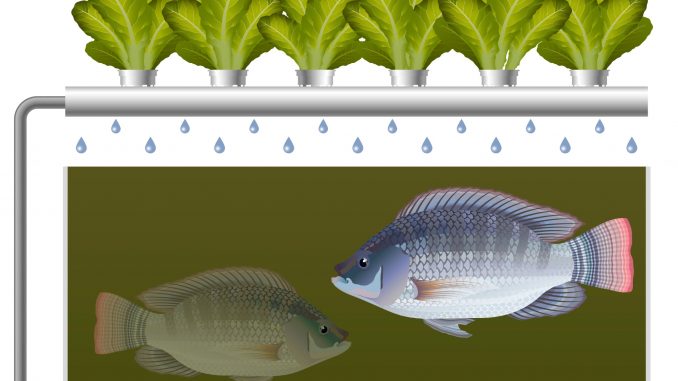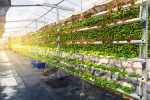
Aquaponics is a sustainable method of farming that combines aquaculture (the raising of aquatic animals) and hydroponics (the cultivation of plants in water). In an aquaponic system, fish or other aquatic animals are raised in a tank, and the nutrient-rich wastewater produced by the fish is then used to fertilize plants grown in a soil-free environment. The plants, in turn, purify the water, which is then recirculated back into the fish tank. This creates a closed-loop system that requires very little water and produces both food and fertilizer.
The basic components of an aquaponic system include a fish tank, a grow bed or beds, and a pump to circulate water between the two. The fish are fed a balanced diet, and their waste is broken down by bacteria in the water into nitrogen compounds such as ammonia and nitrate. These compounds are toxic to fish in high concentrations, but they are an excellent source of nutrients for plants.
The grow bed or beds are typically filled with a growing medium such as gravel or expanded clay pellets, which provide support for the plant roots. The water from the fish tank is pumped into the grow bed, where it is distributed evenly over the surface. As the water flows through the grow bed, the plants absorb the nutrients they need, and the water is purified.
One of the key benefits of aquaponics is that it is a highly efficient method of farming. Because the system is a closed-loop system, it requires very little water and produces no waste. In addition, the plants and fish can be grown in the same system, which reduces the need for space and resources. This makes aquaponics a particularly attractive option for urban farmers or others with limited space.
Another benefit of aquaponics is that it is a sustainable method of farming. Because the system is self-contained, there is no runoff or pollution to nearby waterways. In addition, aquaponic systems can be powered by renewable energy sources such as solar panels, which further reduces their environmental impact.
One of the challenges of aquaponics is that it can be a complex system to set up and maintain. The balance of nutrients and bacteria in the water must be carefully monitored and adjusted to ensure that both the fish and the plants are healthy. In addition, the system must be carefully designed to ensure that the water is distributed evenly throughout the grow bed and that the plants receive the nutrients they need.
Another challenge of aquaponics is that it requires a certain level of expertise to manage. Because the system is complex and relies on the interaction of many different factors, growers must have a good understanding of aquaculture, hydroponics, and the interactions between the two.
Despite these challenges, aquaponics has the potential to revolutionize the way we produce food. By combining aquaculture and hydroponics, aquaponics offers a sustainable and efficient method of farming that can be adapted to a wide range of environments. Aquaponic systems are already being used around the world to produce a variety of crops, from leafy greens to tomatoes to strawberries.
The Future of Aquaponics in Controlled Environmental Agricultural Techniques
As we move forward in our drive to meet the demands of global food production, there has been a heavy reliance on open field agriculture. Up to now the open field system has been the majority user of arable land and water use in agriculture. Unfortunately, this form of farming is the biggest contributor to eutrophication. It’s also a threat to terrestrial and aquatic habitats as well as biodiversity (Poore & Nemcek, 2018). Aquaponics is a typical example of a controlled environment agricultural technique (CEA). We mentioned hydroponics but it also includes vertical farming too. As we evolve our use of land, sea and air we seek resources to ameliorate for the practices of open-file food agriculture.
One of the benefits of aquaponics is that it can be used to grow a wide variety of crops. Because the nutrient-rich water can be customized to meet the needs of different plants, aquaponic systems can be used to grow a wide range of fruits, vegetables, and herbs. In addition, because the system is soil-free, growers can avoid many of the soil-borne pests and diseases that can affect traditional farming methods.
Aquaponics also has the potential to provide a sustainable source of protein in the form of fish or other aquatic animals. By combining fish farming with hydroponics, aquaponic systems can produce both food and fertilizer, making them a more efficient and sustainable option than traditional fish farming methods.
References
, & (2018). Reducing food’s environmental impacts through producers and consumers. Science, 360(6392), pp. 987–992.

Leave a Reply